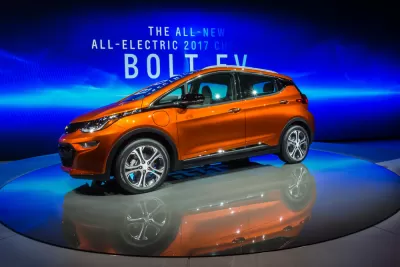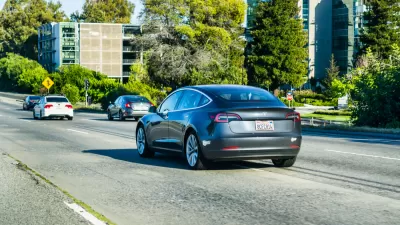It costs less than $40,000 and gets over 200 miles to a charge. The Tesla Model 3? Yes, and also the Chevy Bolt, which goes to market first. A New York Times technology columnist writes that 'size matters' when it comes to innovation.

Remember the 2006 documentary film, "Who Killed the Electric Car?," by Chris Paine? The film shows how General Motors targeted its own EV1, a fully battery-electric vehicle manufactured to comply with a 1990 zero emissions vehicle mandate by the California Air Resources Board (CARB), for destruction.
Just over a thousand vehicles were leased in 1996. The film illustrates how G.M. showed there was no real demand for them in order to take them back at the end of the lease period in 1999 and crush them, regardless of how pleased leaseholders were with their vehicles.
Fast forward 20 years and General Motors is so adamant about building the 'first inexpensive long-range electric on the road' that it is in a race with industry leader Tesla, Silicon Valley's darling carmaker.
"A first affordable long-range electric car, which I drove last month and which blew my mind, is not a Tesla," writes Farhad Manjoo, technology columnist with the The New York Times. "I had to fly from Silicon Valley to Detroit to drive it because the vehicle was invented not by a celebrated start-up, but by that hoariest cliché of tarnished American manufacturing glory, Chevrolet, which is owned by General Motors."
The car is the Chevy Bolt EV, a squat, wedge-shaped compact hatchback. It is an important car for G.M., and, in a larger sense, for the traditional auto industry. It demonstrates the seriousness with which automakers are taking the threat posed by start-ups that are promising to alter everything about the car business. Not only is the Bolt the first inexpensive long-range electric on the road, but it will also function as G.M.’s platform for testing new models for ride-sharing and autonomous driving.
The Bolt is also proof that, in the car industry, size matters — that even if they may be slow to come around to the latest tech, big automakers can alter the car business even more radically than Tesla has, purely as a function of their bigness.
Just as Elon Musk's 2006 'secret master plan' for developing the Model S, and now the Model 3, began with "plowing profits from [a two-seat roadster that sold for $110,000] into research and production capacity," G.M., as well as other large automakers, do the same, but on a much bigger scale.
G.M. enjoys the regulatory advantage of producing a fleet. Because the high-mileage, zero-emission Bolt helps the company stay under the federal government’s fuel-economy standards, it perversely allows G.M. to keep selling more profitable, gas-guzzling cars, like the Tahoe S.U.V. As a result, G.M. could lose money on each Bolt and still find the overall project valuable to its bottom line.
So, in a perverse sort of way, all those folks who are buying SUVs may be enabling automakers to manufacture the next generation of emission-free vehicles.
The Model 3 goes on sale 'the last quarter of 2017.' The Bolt will be available 'later this year.'
- San Francisco Chronicle: "Chevy Bolt a Tesla killer? Probably not, but it’s a fun ride," by David R. Baker, Sept. 14, 2016
- Planetizen: Is Tesla Ready for an Apple Moment?, April 14, 2016
- Wired: "Power Play: The Inside Story of How GM (Yes, GM!) Beat Elon Musk in the Race to Build a True Electric Car for the Masses," by Alex Davies, February 2016
Hat tip to Len Conly
FULL STORY: How Did G.M. Create Tesla’s Dream Car First?

Alabama: Trump Terminates Settlements for Black Communities Harmed By Raw Sewage
Trump deemed the landmark civil rights agreement “illegal DEI and environmental justice policy.”

Planetizen Federal Action Tracker
A weekly monitor of how Trump’s orders and actions are impacting planners and planning in America.

The 120 Year Old Tiny Home Villages That Sheltered San Francisco’s Earthquake Refugees
More than a century ago, San Francisco mobilized to house thousands of residents displaced by the 1906 earthquake. Could their strategy offer a model for the present?

Ken Jennings Launches Transit Web Series
The Jeopardy champ wants you to ride public transit.

BLM To Rescind Public Lands Rule
The change will downgrade conservation, once again putting federal land at risk for mining and other extractive uses.

Indy Neighborhood Group Builds Temporary Multi-Use Path
Community members, aided in part by funding from the city, repurposed a vehicle lane to create a protected bike and pedestrian path for the summer season.
Urban Design for Planners 1: Software Tools
This six-course series explores essential urban design concepts using open source software and equips planners with the tools they need to participate fully in the urban design process.
Planning for Universal Design
Learn the tools for implementing Universal Design in planning regulations.
Clanton & Associates, Inc.
Jessamine County Fiscal Court
Institute for Housing and Urban Development Studies (IHS)
City of Grandview
Harvard GSD Executive Education
Toledo-Lucas County Plan Commissions
Salt Lake City
NYU Wagner Graduate School of Public Service




























